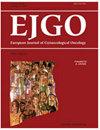Clinical Characteristics and Risk Factors Analysis for the Recurrence of Pelvic Endodermal Sinus Tumors
IF 0.5
4区 医学
Q4 OBSTETRICS & GYNECOLOGY
引用次数: 0
Abstract
Background: This study investigated the clinicopathological characteristics and factors influencing the recurrence of pelvic endodermal sinus tumor. Methods: Fifty-four cases were retrospectively analyzed from at the Zhejiang Cancer Hospital. Imaging and serological indicators were used to determine whether disease recurred, to evaluate progression-free survival, and to compare the influence of related factors on disease recurrence. SPSS 19.0 software was used for statistical analysis. Statistical significance was defined as p < 0.05. Results: The median age at initial treatment was 21 years (range, 11–52 years). Six patients had extragonadal endodermal sinus tumor, and four had histological features of endodermal sinus tumor combined with embryonal carcinoma. Thirty-nine patients underwent fertility-preserving surgery, 18 patients had a childbearing history, and eight patients had residual tumor after initial treatment. Twenty-six patients had a tumor diameter of more than 15 cm, and 30 patients had a serum α‑fetoprotein level greater than 10,000 ng/mL before initial management. The median follow-up time was 47.5 months (range, 14–212 months). During follow-up, 15 patients experience recurrence, with a recurrence rate of 27.8% and a 5-year PFS rate of 61.1%. In univariate analysis, the International Federation of Gynecology and Obstetrics stage (stage III-IV VS. I-II; HR= 10.054 p<0.001), residual tumor (yes VS. no for the first surgery; HR=5.014 p=0.001), histological features (endodermal sinus tumor combined with embryonal carcinoma VS. endodermal sinus tumor; HR=4.130 p=0.018), and use of platinum-based chemotherapy (courses≥3 VS. courses<3; HR= 0.188 p=0.004) were independent factors influencing recurrence; age, childbearing history, tumor site, tumor size, and serum α-fetoprotein level before initial management did not affect recurrence. In multivariate analysis, only stage was an independent risk factor for progression-free survival(stage III-IV VS. I-II; HR=6.923 p=0.019). Conclusions: Stage is a prognostic factor for recurrence of pelvic endodermal sinus tumor. The first surgery should remove the tumor as completely as possible, and initial treatment should require a sufficient dose and full course of platinum-based chemotherapy, which may reduce the recurrence rate. Patients with endodermal sinus tumor and embryonal carcinoma may have increased susceptibility of recurrence.盆腔内胚层窦肿瘤复发的临床特点及危险因素分析
背景:探讨盆腔内胚层窦肿瘤的临床病理特点及影响复发的因素。方法:对浙江省肿瘤医院收治的54例肿瘤患者进行回顾性分析。通过影像学和血清学指标判断疾病是否复发,评估无进展生存期,比较相关因素对疾病复发的影响。采用SPSS 19.0软件进行统计分析。p < 0.05为差异有统计学意义。结果:初始治疗时的中位年龄为21岁(范围11-52岁)。6例患者有掌外内胚层窦肿瘤,4例有内胚层窦肿瘤合并胚胎癌的组织学特征。39例患者行保生育手术,18例患者有生育史,8例患者初始治疗后肿瘤残留。26例患者肿瘤直径大于15 cm, 30例患者初始治疗前血清α -胎蛋白水平大于10,000 ng/mL。中位随访时间为47.5个月(14-212个月)。随访期间15例复发,复发率27.8%,5年PFS为61.1%。在单变量分析中,国际妇产科联合会的阶段(III-IV期VS. I-II期;HR= 10.054 p<0.001),残余肿瘤(首次手术是VS.否;HR=5.014 p=0.001)、组织学特征(内皮窦肿瘤合并胚胎癌VS.内皮窦肿瘤;HR=4.130 p=0.018),使用铂类化疗(≥3个疗程vs <3个疗程;HR= 0.188 p=0.004)是影响复发的独立因素;初始治疗前的年龄、生育史、肿瘤部位、肿瘤大小、血清α-胎蛋白水平对复发率无影响。在多变量分析中,只有分期是无进展生存的独立危险因素(III-IV期VS. I-II期;HR = 6.923 p = 0.019)。结论:分期是骨盆内胚层窦肿瘤复发的预后因素。第一次手术应尽可能完全切除肿瘤,初始治疗需要足够的剂量和全疗程的铂类化疗,这可能会降低复发率。内胚层窦肿瘤和胚胎癌患者可能有更高的复发易感性。
本文章由计算机程序翻译,如有差异,请以英文原文为准。
求助全文
约1分钟内获得全文
求助全文
来源期刊
自引率
25.00%
发文量
58
审稿时长
1 months
期刊介绍:
EJGO is dedicated to publishing editorial articles in the Distinguished Expert Series and original research papers, case reports, letters to the Editor, book reviews, and newsletters. The Journal was founded in 1980 the second gynaecologic oncology hyperspecialization Journal in the world. Its aim is the diffusion of scientific, clinical and practical progress, and knowledge in female neoplastic diseases in an interdisciplinary approach among gynaecologists, oncologists, radiotherapists, surgeons, chemotherapists, pathologists, epidemiologists, and so on.

 求助内容:
求助内容: 应助结果提醒方式:
应助结果提醒方式:


